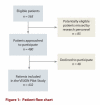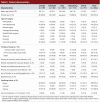An international prospective cohort study evaluating major vascular complications among patients undergoing noncardiac surgery: the VISION Pilot Study
- PMID: 22567075
- PMCID: PMC3345376
An international prospective cohort study evaluating major vascular complications among patients undergoing noncardiac surgery: the VISION Pilot Study
Abstract
Objectives: among patients undergoing noncardiac surgery, our objectives were to: (1) determine the feasibility of undertaking a large international cohort study; (2) estimate the current incidence of major perioperative vascular events; (3) compare the observed event rates to the expected event rates according to the Revised Cardiac Risk Index (RCRI); and (4) provide an estimate of the proportion of myocardial infarctions without ischemic symptoms that may go undetected without perioperative troponin monitoring.
Design: An international prospective cohort pilot study.
Participants: Patients undergoing noncardiac surgery who were >45 years of age, receiving a general or regional anesthetic, and requiring hospital admission.
Measurements: Patients had a Roche fourth-generation Elecsys troponin T measurement collected 6 to 12 hours postoperatively and on the first, second, and third days after surgery. Our primary outcome was major vascular events (a composite of vascular death [i.e., death from vascular causes], nonfatal myocardial infarction, nonfatal cardiac arrest, and nonfatal stroke) at 30 days after surgery. Our definition for perioperative myocardial infarction included: (1) an elevated troponin T measurement with at least one of the following defining features: ischemic symptoms, development of pathologic Q waves, ischemic electrocardiogram changes, coronary artery intervention, or cardiac imaging evidence of myocardial infarction; or (2) autopsy findings of acute or healing myocardial infarction.
Results: We recruited 432 patients across 5 hospitals in Canada, China, Italy, Colombia, and Brazil. During the first 30 days after surgery, 6.3% (99% confidence interval 3.9-10.0) of the patients suffered a major vascular event (10 vascular deaths, 16 nonfatal myocardial infarctions, and 1 nonfatal stroke). The observed event rate was increased 6-fold compared with the event rate expected from the RCRI. Of the 18 patients who suffered a myocardial infarction, 12 (66.7%) had no ischemic symptoms to suggest myocardial infarction.
Conclusions: This study suggests that major perioperative vascular events are common, that the RCRI underestimates risk, and that monitoring troponins after surgery can assist physicians to avoid missing myocardial infarction. These results underscore the need for a large international prospective cohort study.
Conflict of interest statement
Competing interests: None declared.
Figures
References
-
- Weiser Thomas G, Regenbogen Scott E, Thompson Katherine D, Haynes Alex B, Lipsitz Stuart R, Berry William R, Gawande Atul A. An estimation of the global volume of surgery: a modelling strategy based on available data. Lancet. 2008;372(9633):139–144. doi: 10.1016/S0140-6736(08)60878-8. http://linkinghub.elsevier.com/retrieve/pii/S0140673608608788. - DOI - PubMed
-
- Devereaux P J, Chan M, Eikelboom J. Major vascular complications in patients undergoing noncardiac surgery: The magnitude of the problem, risk prediction, surveillance, and prevention. In: Yusuf S, Cairns J A, Camm A J, Fallen E L, Gersh B J, editors. Evidence based cardiology. 3rd ed. London (UK): BMJ Books; 2009. pp. 47–62.
-
- Devereaux P J, Goldman Lee, Cook Deborah J, Gilbert Ken, Leslie Kate, Guyatt Gordon H. Perioperative cardiac events in patients undergoing noncardiac surgery: a review of the magnitude of the problem, the pathophysiology of the events and methods to estimate and communicate risk. CMAJ. 2005 Sep 13;173(6):627–634. doi: 10.1503/cmaj.050011. http://www.ncbi.nlm.nih.gov/pmc/articles/pmid/16157727. - DOI - PMC - PubMed
-
- Devereaux P J, Goldman Lee, Yusuf Salim, Gilbert Ken, Leslie Kate, Guyatt Gordon H. Surveillance and prevention of major perioperative ischemic cardiac events in patients undergoing noncardiac surgery: a review. CMAJ. 2005 Sep 27;173(7):779–788. doi: 10.1503/cmaj.050316. http://www.ncbi.nlm.nih.gov/pmc/articles/pmid/16186585. - DOI - PMC - PubMed
Publication types
MeSH terms
Substances
LinkOut - more resources
Full Text Sources
Medical




